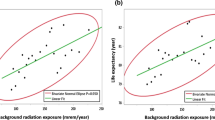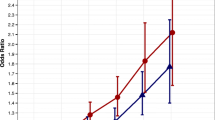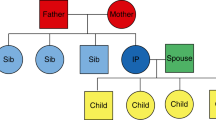Abstract
Cross-generational effects (grandmother effects) associated with epigenetic imprinting, environmental exposures, and lifestyle choices are beginning to be explored by various investigators. The possibility that low-level background radiation can be a driver of such effects has been suggested previously and is explored further in this study. Age-period-cohort analysis was performed on United States (US), United Kingdom (UK), and Australian (AU) female breast cancer mortality of the twentieth century, as well as on UK female total cancer mortality, to extract the high-frequency oscillations in the birth cohort time series. US fetal and infant congenital mortality were examined to extend the birth cohorts to modern times. A ∼17-year cycle was detected in all birth cohort series, which spanned approximately 180 years from 1820 to 2000. This suggests a global, environmental cause. To mimic previous work in examining a possible link to cosmic radiation, the 17- to 18-year cycles of the cosmogenic nuclide 14C, the sunspot double-cycle, neutron monitors, and a compilation of ground-based magnetic field observations were examined in the birth cohort and germ cell cohort time frames. Evidence is presented that optimal alignments with extraterrestrial oscillations occur in the time frame of the germ-cell cohort, one generation before the birth cohorts. Furthermore, the alignment is optimized by accounting for the changes in the maternal age distribution over time. These findings have potential importance to the mechanisms of disease as well as species adaptation and evolution.













Similar content being viewed by others
References
BRER (Board on Radiation Effects Research) (2006) Health risks from exposure to low levels of ionizing radiation: BEIR VII, phase 2 The National Academies Press, Washington.
Castillo E (1988) Extreme value theory in engineering. Academic, San Diego
Chaney EK, Sliney DH (2005) Re-evaluation of the ultraviolet hazard action spectrum - the impact of spectral bandwidth. Health Phys 89:322–332. doi:10.1097/01.HP.0000164650.96261.9d
Durante M, Manti L (2008) Human response to high-background radiation environments on Earth and in space. Adv Space Res 42:999–1007. doi:10.1016/j.asr.2007.02.014
Frejka T, Sardon J-P (2004) Childbearing trends and prospects in low-fertility countries: a cohort analysis. Kluwer, Dordrecht, pp 373–374
Gilbert SF, Epel D (2009) Ecological developmental biology: integrating epigentics, medicine, and evolution. Sinauer, Sunderland, MA
Godar DE, Wengraitis SP, Shreffler J, Sliney DH (2001) UV Doses of Americans. Photochem Photobiol 73:621–629. doi:10.1562/0031-8655(2001)073<0621:UDOA>2.0.CO;2
Heimers A (1999) Cytogenetic analysis in human lymphocytes after exposure to simulated cosmic radiation which reflects the inflight radiation environment. Int J Radiat Biol 75:691–698. doi:10.1080/095530099140023
Hoyt DV, Schatten KH (1998) Group sunspot numbers: a new solar activity reconstruction. Sol Phys 181:491–512. doi:10.1023/A:1005056326158
Joyce P, Rokyta D, Beisel CJ, Orr HA (2008) A general extreme value theory model for the adaptation of DNA sequences under strong selection and weak mutation. Genetics 180:1627–1643. doi:10.1534/genetics.108.088716
Juckett DA (1998) Evidence for a 17-year cycle in the IMF directions at 1 AU, in solar coronal hole variations, and in planetary magnetospheric modulations. Sol Phys 183:201–224. doi:10.1023/A:1005075703810
Juckett DA (2001) Period and phase comparisons of near-decadal oscillations in solar, geomagnetic, and cosmic ray time series. J Geophys Res 106:18651–18665. doi:10.1029/2000JA000367
Juckett DA (2007) A 140-year global time signature in cancer mortality birth cohorts correlates to galactic cosmic ray variation. Int J Astrobiol 6:307–319
Juckett DA, Rosenberg B (1993) Correlation of human longevity oscillations with sunspot cycles. Radiat Res 133:312–320. doi:10.2307/3578215
Juckett DA, Rosenberg B (1997) Time series analysis supporting the hypothesis that enhanced cosmic radiation during germ cell formation can increase breast cancer mortality in germ cell cohorts. Int J Biometeorol 40:206–222
Lim MK (2002) Cosmic rays: are air crew at risk? Occup Environ Med 59:428–432. doi:10.1136/oem.59.7.428
Mahmoud BH, Hexsel CL, Hamzavi IH, Lim HW (2008) Effects of visible light on the skin. Photochem Photobiol 84:450–462. doi:10.1111/j.1751-1097.2007.00286.x
Medvedev MV, Melott AL (2007) Do extragalactic cosmic rays induce cycles in fossil diversity? Astrophys J 664:879–889. doi:10.1086/518757
Melott AL, Krejci AJ, Thomas BC, Medvedev MV, Wilson GW, Murray MJ (2008) Atmospheric consequences of cosmic-ray variability in the extragalactic shock model. J Geophys Res 113:E10007. doi:10.1029/2008JE003206
National Archive of the UK (n.d.) National Digital Archive of Datasets. Historic Mortality Data Files RG 69. NDAD: CRDA/20, 1901–1992
Parkin DM, Whelan SL, Ferlay J, Teppo L, Thomas DB (eds) (2002) Cancer incidence in five continents Vol VIII Lyon France: International Agency for Research on Cancer (IARC scientific publication 155)
Sliney DH (2000) Ultraviolet radiation exposure criteria. Radiat Prot Dosimetry 91:213–222
Sonett CP, Webb GM, Zakharian A (1997) The quest for evidence of long-period solar wind variability. In: Jokipii JR, Sonett CP, and Giampapa MS (eds) Cosmic winds and the heliosphere. University of Arizona Press, pp 67–110
Stoupel EG, Frimer H, Appelman Z, Ben-Neriah Z, Dar H, Fejgin MD, Gershoni-Baruch R, Manor E, Barkai G, Shalev S, Gelman-Kohan Z, Reish O, Lev D, Davidov B, Goldman B, Shohat M (2005) Chromosome aberration and environmental physical activity: down syndrome and solar and cosmic ray activity, Israel, 1990–2000. Int J Biometeorol 50:1–5. doi:10.1007/s00484-005-0274-2
Stuiver M, Reimer PJ, Braziunas TF (1998) High-precision radiocarbon age calibration for terrestrial and marine samples. Radiocarbon 40:1127–1151
Thomson DJ (1982) Spectrum estimation and harmonic analysis. Proc IEEE 70:1055–1096. doi:10.1109/PROC.1982.12433
US Department of Health and Human Services (n.d.) Vital Statistics of the United States 1939–2006, National Center for Health Statistics. Government Printing Office, Washington, D.C.
US Bureau of the Census (n.d.a) Mortality Statistics 1900–1938. Government Printing Office, Washington, D.C.
US Bureau of the Census (n.d.b) Census of the Population United States, 1900, 1910, 1920, 1930, 1940. Government Printing Office, Washington, D.C.
US Bureau of the Census (1945) Sixteenth Census of the United States 1940. Population Differential Fertility 1940 and 1910. Government Printing Office, Washington, D.C.
Vautard R, Yiou P, Ghil M (1992) Singular-spectrum analysis: A toolkit for short, noisy chaotic signals. Physica D 58:95–126. doi:10.1016/0167-2789(92)90103-T
Willigan JD, Mineau GP, Anderton DL, Bean LL (1982) A macrosimulation approach to the investigation of natural fertility. Demography 19:161–176. doi:10.2307/2061188
Wilson PR (1994) Solar and stellar activity cycles. Cambridge University Press, Cambridge, pp 16–23
Acknowledgements
This work was supported by the Barros Research Institute and by a joint operating agreement grant from the Michigan State University Foundation.
Author information
Authors and Affiliations
Corresponding author
Rights and permissions
About this article
Cite this article
Juckett, D.A. A 17-year oscillation in cancer mortality birth cohorts on three continents – synchrony to cosmic ray modulations one generation earlier. Int J Biometeorol 53, 487–499 (2009). https://doi.org/10.1007/s00484-009-0237-0
Received:
Revised:
Accepted:
Published:
Issue Date:
DOI: https://doi.org/10.1007/s00484-009-0237-0




